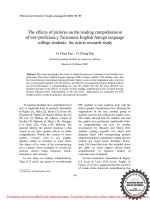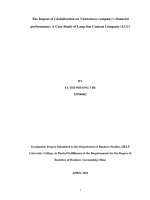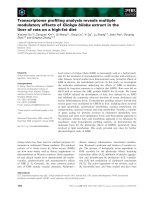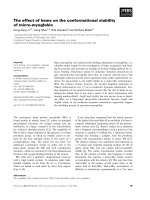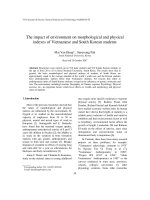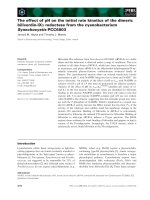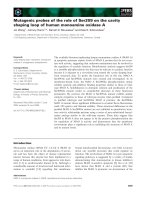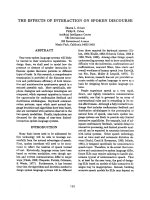The influences of culture on translation
Bạn đang xem bản rút gọn của tài liệu. Xem và tải ngay bản đầy đủ của tài liệu tại đây (1.16 MB, 61 trang )
Graduation Paper
HANOI OPEN UNIVERSITY
FACULTY OF ENGLISH
====o0o====
GRADUATION THESIS
B.A DEGREE IN ENGLISH STUDIES
THE INFLUENCES OF CULTURE ON TRANSLATION
.
Supervisor
: Nguyen Thi Thu Huong, M.A.
Student
: Bien Thi Van Anh
Date of birth
: 20/02/1993
Course
: K18A2 (2011-2015)
Hanoi – 2015
Bien Thi Van Anh - Group K18A2 – Course 2011-2015
Graduation Paper
DECLARATION
Title: The Influences of Culture on Translation
I certify that no part of report has been copied or reproduced by me from
any other’s work without acknowledgement and that the report is originally
written by me under strict guidance of my supervisor.
Hanoi, 03 May, 2015
Student
Supervisor
signature
signature
Full name
Full name
Bien Thi Van Anh - Group K18A2 – Course 2011-2015
Graduation Paper
ACKNOWLEDGEMENTS
First and foremost, I would like to express my sincere thanks to my
supervisor, Mrs.Nguyen Thi Thu Huong, lecturer of Hanoi Open University.
This study could have probably not completed without her patient,
enthusiastic and instructive supervision and encouragement.
I also would like to show my profound gratitude to all the lecturers in the
Faculty of English, Hanoi Open University for tirelessly devoting time and
efforts to enrich, broaden and deepen my knowledge over the past 4 years.
My special thanks go as well as to the English Department of Hanoi Open
University for giving me the opportunity and permission to implement this
study.
Besides, I am deeply indebted to my beloved family for their
wholehearted support and encouragement. I also would like to dedicate my
special thanks to my classmates in K18-A2, who have supported, cooperated
and provided me with valuable suggestions.
Finally, I cannot fully express my gratitude to all the people whose direct
and indirect support assisted me to accomplish my thesis in time.
Bien Thi Van Anh - Group K18A2 – Course 2011-2015
Graduation Paper
Table of Contents
Part A: Introduction ...................................................................................... 1
1. Rationale ................................................................................................ 1
2.Aims and Objective of the study ............................................................... 1
3.Scope of the study .................................................................................... 2
4.Research questions .................................................................................. 2
5.Methods of the study ................................................................................ 2
6.Design of the study .................................................................................. 3
Part B: Contents ............................................................................................ 4
Chapter 1: Some basis theories of translation .............................................. 4
1.1 Definition of translation ....................................................................... 4
1.2
Development direction of translation ................................................ 5
1.3
The nature of translation................................................................... 6
1.4
Some main methods of translation .................................................... 7
1.4.1
Word_ for_word translation ...................................................... 8
1.4.2
Literal translation ...................................................................... 8
1.4.3
Faithful translation ..................................................................... 9
1.4.4 Semantic translation .................................................................... 9
1.4.5 Communicative translation ........................................................ 10
1.4.6 Idiomatic translation ................................................................. 10
1.4.7 Free translation ......................................................................... 10
1.4.8 Adaptation translation ................................................................ 11
Chapter 2: Some concepts of culture .......................................................... 12
2.1 Origin of the term "culture"................................................................ 12
2.2 Inadequate Conceptions of Culture ................................................... 13
2.2.1 Culture is homogenous ................................................................ 13
2.2.2 Culture is a thing ........................................................................ 14
2.2.3 Culture is uniformly distributed among members of a group ...... 14
2.2.4 An individual possesses but a single culture ................................ 14
Bien Thi Van Anh - Group K18A2 – Course 2011-2015
Graduation Paper
2.2.5 Culture is custom ......................................................................... 15
2.2.6 Culture is timeless ...................................................................... 15
2.3 Conclusion About the Conceptualization of Culture .......................... 15
Chapter 3: Influences of culture on translation ......................................... 17
3.1 The relation between language and culture ........................................ 17
3.2 The influence of culture on translation at word level ......................... 19
3.2.1 Word relating to festival .............................................................. 19
3.2.2 Word relating to custom .............................................................. 20
3.2.3 Vocative and personal pronouns .................................................. 22
3.2.4 Verb ............................................................................................. 23
3.2.5 Adjective ...................................................................................... 25
3.2.6 Preposition .................................................................................. 26
3.2.7 Noun of symbolic images ............................................................. 27
3.3 The influences of culture on translation at phrase level ....................... 30
3.3.1 Comparative idiom ...................................................................... 30
3.3.1.1 Comparative idiom of shape and appearance ....................... 30
3.3.1.2 Comparative idiom of personality ......................................... 32
3.3.1.3 Comparative idiom of colour ................................................ 33
3.3.2 Metaphoric idiom ........................................................................ 35
3.3.2.1 Idiom relating to food ........................................................... 35
3.3.2.2 Metaphoric idiom relating to animal..................................... 37
3.3.2.2 Metaphoric idiom relating to body part ................................ 39
Chapter 4: Recommendations ..................................................................... 42
4.1 Some basic principles of translation ................................................... 42
4.1.1 The first general principle ........................................................... 42
4.1.2 The second general principle ...................................................... 43
4.1.3 The third general principle .......................................................... 43
4.2 Strategies to tackle non-equivalent at word level .............................. 43
4.2.1 Translating by a more specific word ........................................... 44
4.2.2 Translating by a more general word ............................................ 45
Bien Thi Van Anh - Group K18A2 – Course 2011-2015
Graduation Paper
4.2.3 Translating by a more neutral / less expressive word.................. 45
4.2.4 Translating by substitution ......................................................... 46
4.2.5 Translating by using a loan word plus explanation...................... 47
4.2.6 Translating by using a paraphrase .............................................. 47
4.2.7 Translating by omission ............................................................... 48
4.2.8 Translating by illustratation ........................................................ 49
4.3 Strategies to tackle non-equivalence at phrasal level.......................... 49
4.3.1 Using an idiom of similar mean and form .................................... 49
4.3.2 Using an idiom of similar meaning but dissimilar form ............... 50
4.3.3 Translating by paraphrase .......................................................... 51
Part C: Conclusion ...................................................................................... 53
References ................................................................................................... 55
Bien Thi Van Anh - Group K18A2 – Course 2011-2015
Part A: Introduction
1. Rationale
Language is a phenomenon and a factor that links different cultures and a
way to express feeling and ideas that people try to convey. Study on language,
culture and translation and the relationship between them are valuable issues
because of their importance to human communication in the world. The
variety of languages and the cultural difference and necessity of
communication in human life caused translation to be a very effective factor
in communicating, exchanging cultures and knowledge. Hence, the role of
translators is more and more highly appreciated. Although there might be no
specific frame and force on how translation must be done, all translators who
desire perfect translations often base on many factors, especially culture.
There have been
many studies so far on the influences of culture on
translation. However, they have not focused much on lexical level but on
pragmatic or syntactic one. Thus, in this study, I choose cultural barrier in
translation of words and phrases in English and Vietnamese as the main
subject in my study.
2.Aims and Objective of the study
Understanding about the influence of culture on translation on word and
phrase level is the prime aim of my study from that we can know how to
apply translation techniques and skills. Moreover, we can understand more
about cultural concerns in translation, know the way to solve problems, how
to use specialized terminology in some fields, such as, political-social,
literary-art, scientific-technical terms. In addition, the paper concentrates on
analyzing in details the cultural influence on Vietnamese-English translation
and English-Vietnamese one. The primary aim of the study is to share with
students of English, who would be translators, an overview of the frequently
Bien Thi Van Anh - Group K18A2 – Course 2011-2015
1
seen influence of culture on Vietnamese-English and English-Vietnamese
translation. So that they are fully aware and able to produce a correct
translation.
The paper also aims at finding some possible strategies to improve the
difficulties to Vietnamese-English translation. Nevertheless, all people who
are interested in translation work can consider it a useful reference to improve
their translating skills.
3.Scope of the study
The study mainly focuses on the impacts of culture on VietnameseEnglish and English-Vietnamese translation on word and phrase level.
4.Research questions
- What is the concept of culture?
- What is translation?
- How does culture affect translation?
- What are some types of cultural problems of translation of words and
phrases from English into Vietnamese and vice versa?
- How can we do to translate effectively?
5.Methods of the study
Collecting sample and data analysis are the two main methods used in
the study. I collect examples and samples on word and phrase level to analyze
the influence of culture on Vietnamese-English and English-Vietnamese
translation, from that I recommend solutions for translator to transfer text
containing cultural factor effectively.
Bien Thi Van Anh - Group K18A2 – Course 2011-2015
2
6.Design of the study
As can be seen from the content page, I divided my study into 3 parts:
The first part is an introduction, this part focuses on rationale, aims and
objective, scope, methods, research questions and design of the study.
The second part is the main contents of the report including:
Chapter 1: Some basis theories of translation (this part focuses on
definition of translation, development direction of translation, nature of
translation, some main methods of translation).
Chapter 2: Some concepts of culture (in this chapter, I will show origin
of the term "culture", inadequate conceptions of culture and conclusion about
the conceptualization of culture).
Chapter 3: Influences of culture on translation (focus on the relation
between language and culture, the influence of culture on translation in term
of word, the influences of culture on translation in term of phrase).
Chapter 4: My recommendation (focus on principles of translation,
strategies to deal with non-equivalence at word and phrase level).
The third part is conclusion (brief overview and summary of the study,
final comments).
Bien Thi Van Anh - Group K18A2 – Course 2011-2015
3
Part B: Contents
Chapter 1: Some basis theories of translation
1.1 Definition of translation
Translation plays an important role in human communication, and the
importance of it has grown dramatically in the 20th century, the amount of
information and ideas exchanged among different languages has increased.
Yet, the emergence of translation as a recent profession that is still surrounded
with controversy much of which emotionally inspired (Citroen, 1966:12).
The fact that translation has been a subject of constant controversy and
that many scholars have different views about it, has resulted in presenting
several definitions concerning the process of translation.
Culture is defined as the way of life and its manifestations which are
unique to a society that uses a particular language as it means of expression
(Newmark, 1988: 94).
Nida and Taber (1974:12) mention that translation is concerned with
reproducing in the target language the closet natural equivalence of the source
language message, first in terms of meaning and secondly in terms of style,
but in contrast to others, translation is approached as a search for equivalent
not sameness of meaning.
Suleiman (1999:145) states that translation, is an art and skill, is an
intergrated
process
which
involves
the
comprehension,
analysis,
reformulation of text by incorporating the contextual, semantic and sociocultural aspects of source language and target language text.
In short, translation is the communication of the meaning of a source
language text by means of an equivalent target language text. Translation is a
Bien Thi Van Anh - Group K18A2 – Course 2011-2015
4
linguistic action in which translators play an important role in making
wonderful products. Translators are required to have not only a very good
knowledge of the language, written and spoken, from which they are
translating (the source language) but also an excellent command of the
language into which they are translating (the target language). Translators
need to be familiar with the subject matter of the text being translated and
have a finely tuned sense of when to translate literally and when to
paraphrase, so as to assure true rather than spurious equivalents between the
source and target language texts.
1.2 Development direction of translation
Due to the demand of business documentation consequent to the
industrial Revolution that began in the mid – 18th century, some translation
specialties have become formalized, with dedicated schools and professional
associations.
Because of the laboriousness of translation, since the 1940s engineers
have sought to automate translation (machine translation). The rise of the
Internet has fostered a worldwide market for translation services and has
facilitated language localization.
Translation studies deal with the systematic study of the theory, the
description and the application of translation. Nowadays, because of the
integration process, translation study is increasingly developed. Translation
studies still focus on describing the process of translation between languages
and proposing principles as well as models for translation. Reseachers are
required to administer different methods with different point of views of
related sciences to carry out the mission of translation studies. It can be seen
that translation study has developed along with the development of linguistics
and depended on it. However, applying the achievements of linguistics to
Bien Thi Van Anh - Group K18A2 – Course 2011-2015
5
translation study clarifies the nature of linguistic research tendencies. Also, it
seems to be “ a effective reagent” to different linguistic theories.
1.3 The nature of translation
The process of translation bases on the nature of communicative
competence which consists of 4 factors.
1.Linguistic competence is knowing how to use the grammar, syntax,
and vocabulary of a language.
2.Sociolinguistic competence is knowing how to use and respond to
language appropriately, given the setting, the topic and the relationship among
the people communicating.
3.Discource competence is knowing how to interpret the larger context
and how to construct longer stretches of language so that the parts make up a
coherent whole.
4.Strategic competence is knowing how to recognize and repair
communication breakdowns, how to work around gaps in one’s knowledge of
the language, and how to learn more about the language in the context.
The translation process is very complicated, however, it can be assumed
that translation is the communication of the meaning of a source language text
by means of an equivalent target language text.
The translation process can be described simply into 2 steps.
1.Decoding the meaning of the source text.
2.Re_ecoding this meaning in the target language.
To decode the meaning of a text, the translator must first identify its
component “translation units” , that is to say the segments of the text to be
Bien Thi Van Anh - Group K18A2 – Course 2011-2015
6
treated as a cognitive unit. A translation unit may be a word, a phrase or even
one or more sentences.
To decode the complete meaning of the source text, the translation must
consciously and methodically interpret and analysis all its features. This
process requires thorough knowledge of the grammar, semantics, syntax,
idioms and the like of source language, as well as the culture of its speakers.
The translator needs to have the same in _depth knowledge to re-encode
the meaning in the target language. In fact, often translators’knowledge of the
target language is more important, and needs to be deeper, than their
knowledge of the source language. For this reason, most translators translate
into a language of which they are native speakers.
1.4 Some main methods of translation
Translation has been viewed differently by different scholars. There is no
unanimous agreement about its definition, models and types. However, some
scholars attempt to define it and specify its types and models.
Practically, there are some kinds of translation that have their own
characteristics and forms. Some kind of translation are found because of the
differences and similarities of the source structures, different kinds of text that
are going to be translated and diferrent purpose of translation. With regard to
its type and model, Catford (1965) classifies the types of translation according
to rank, extent and level. Newmark (1982) states that translation methods
relate to whole texts, translation procedures are used for sentences and the
smaller units of language.
Roman Jakobson in Hatim and Munday makes a very important
distinction between three types of written translation.
Bien Thi Van Anh - Group K18A2 – Course 2011-2015
7
1.Intralingual translation,translation within the same language, which can
involve rewording or paraphrase.
2. Interlingual translation, translation from one language to another.
3.Intersemiotic translation, translation of the verbal sign by non-verbal
sign for example music or image.
The update methods of translation are those suggested by Newmark
(1982). In what follows, each one of them will be talked about briefly.
1.4.1 Word_ for_word translation
Word for word translation (or sometimes direct/interlinear translation)
focuses mainly on translating words from the source text into the target
language while the word order of the original is preserved. This method of
translation can be seen in those cases where some value of humour is needed.
It is also very useful for the translator to understand and analyze the originall
text before translating it into the target language. For instance, word for word
translation “Bạn đi đâu đấy?” into English can be “You are going where?”
whereas the correct version must be “Where are you going?”, or in the
situation where an Englishman is giving a consolence, saying “No worries or
no problem” (không sao đâu), a Vietnamese word for word translation may
be “No star where”.
1.4.2 Literal translation
Literal translation is featured by the fact that grammatical structures and
the meaning of words are translated almost as closely as those in the target
language without paying attention to the situation or context (In this sense,
many theorists coincide literal translation with word for word translation). For
example, the question “Can you sit down ?” can be literally translated into
Bien Thi Van Anh - Group K18A2 – Course 2011-2015
8
Vietnamese “Anh có thể ngồi xuống được không?”, but in fact it is really a
request which can be communicately translated as “Anh hãy ngồi xuống”,
“Anh ngồi xuống đi”, etc.
1.4.3 Faithful translation
Faithful translation can be described as one kind of translation which
tries to convey the meaning of words and context situation according to the
grammar rules of the target language; however, if the sentence “Tôi e rằng cô
ta không làm được việc đó” (I think she cannot do it) was translated this way,
then the structure of the target language (English) does not sound natural. In
English, the negation of the verb in the first clause stands for the negation of
the verb in the following clause. For this reason, the translation should be “I
do not think she can do it”. Another example may go with the infinitive verb
used as subject of the sentence, a faithful translation of “Học khóa này phải
mất hai năm” (To do this course takes 2 years) may sound unnatural to
English people (It takes two years to do this course).
1.4.4 Semantic translation
Semantic translation focuses to a great degree on meaning (senmantic
content) and form (syntac) of the original texts of high status such as religious
texts, legal texts, literature, or speech es. Using this strategy, the translator
tries to come as close as possible to the meaning conveyed by the words by
means of word order change or word choice (synonyms/antonyms) so that the
true meaning is conveyed. For example, in the case of idioms, “It is water
under the bridge” or “Past water do not power mills” if translated literally
these idioms make little or no sense; however, their meaning (Hãy để cho quá
khứ ngủ yên) could possible be clear if semanic translation is exploited.
Bien Thi Van Anh - Group K18A2 – Course 2011-2015
9
1.4.5 Communicative translation
Communicative translation is freer than the above-mentioned types. This
strategy gives high priority to the message communicated in the text where
the actual form of the original is not closely bound to its intented meaning.
For example, if the sentence “Do you mind closing the door please? No, I
don’t” (Anh có phản đối việc ra vào đóng cửa không? Không, tôi không phản
đối” was translated this way, then the message of the sentence has not yet
been interpreted correctly since this sentence implies a request rather a
question, so the following translation could be accepted (Nhờ anh đóng hộ
cửa ra vào. Vâng / Được thôi).
1.4.6 Idiomatic translation
Idiomatic translation is based on the meaning of the text which aims to
produce the message of the original but tend to distort nuances of meaning by
using idioms and colloquialism where there do not exist in the original. For
example, in Vietnamese to describe a peasant’s hard life, there are such
idioms as : cuộc đời chân lấm tay bùn / một nắng hai sương / bán mặt cho đất
bán lưng cho trời, etc; these idioms can be used to translate the meaning of
“hard life” – the extreme of hardships a peasant has to suffer (a peasant’s
hard life : cuộc đời hai sương một nắng). Another example that describes the
degree of the sameness of the two girl’s appearance “They look exactly the
same” (Chúng giống nhau như hai giọt nước).
1.4.7 Free translation
As indicated by the word “free”, free translation focuses more on content
than form in the target language; as a result, sometimes the grammar structure
of the form of the words in the target language may change; the number of
words and the sentence length may vary, depending on the subjectivity of the
Bien Thi Van Anh - Group K18A2 – Course 2011-2015
10
translator when he/she adds explanation or comment to make clear the
meaning of the original. For example, “business is business” could be
translated freely as “công việc là công việc, không chen tình cảm vào đây
được”.
1.4.8 Adaptation translation
Adaptation is highly free type of translation. Here the focus is on sociocultural phenomena or practices that are absent in the target culture, rather
than operations on linguistic units, although these are of course inevitably
concerned. In other words, adaptation translation aims to create an
equivalence of the same value applicable to a different situation than that of
the source language. Here are some examples. We can imagine a situation in
which speaker will tend to express a wish: Chúc thượng lộ bình an (Have a
safe trip). However, in
the same situation English speakers often say
something different, so the Vietnamese wish could be translated as : See you,
Good bye, Have a nice time, etc. Another example is that when meeting for
the first time, especially when introduced to a guest, English people often say
:How do you do”as a greeting while Vietnamese people say differently;
therefore, this so-called question in English could be equivalent to “Chào
ông/bà/bác, etc.” depending on the age or social status of the person who you
are speaking to. Literal force is of course inevitably lost in these cases and the
best that can be achieved is by means of faithfulness to pragmatic function of
the target language cultural reference or practice.
Bien Thi Van Anh - Group K18A2 – Course 2011-2015
11
Chapter 2: Some concepts of culture
2.1 Origin of the term "culture"
Culture (/ɑkȜltʃər/, from Latin: cultura, lit. "cultivation") is a modern
concept based on a term first used in classical antiquity by the Roman orator,
Cicero: "cultura animi. " The term "culture" appeared first in its current sense
in Europe in the 18th and 19th centuries, to connote a process of cultivation or
improvement, as in agriculture or horticulture. In the 19th century, the term
developed to refer first to the betterment or refinement of the individual,
especially through education, and then to the fulfillment of national
aspirations or ideals. In the mid-19th century, some scientists used the term
"culture" to refer to a universal human capacity.
In the 20th
century, “culture” emerged as a central concept in
anthropology, encompassing the range of human phenomena that cannot be
attributed to genetic inheritance. Specifically, the term “culture” in American
anthropology had two meanings: (1) the evolved human capacity to classify
and represent experiences with symbols, and to act imaginatively and
creatively; and (2) the distinct ways that people living in different parts of the
world acted creatively and classified or represented their experiences.
Distinctions are currently made between the physical artifacts created by a
society, its so-called material culture and everything else, including the
intangibles such as language, customs, etc. that are the main referent of the
term “culture”.
When used as a count noun “a culture”, is the set of customs, traditions
and values of a society or community, such as an ethnic group or nation. In
this sense the concept of multiculturalism is a political ideology that values
the peaceful coexistence and mutual respect between different cultures
inhabiting the same territory. Sometimes “culture” is also used to describe
Bien Thi Van Anh - Group K18A2 – Course 2011-2015
12
specific practices within a subgroup of a society, a subculture (e.g. “bro
culture”), or a counter culture. Within cultural anthropology, the ideology and
analytical stance of cultural relativism holds that cultures cannot easily be
objectively ranked or evaluated because any evaluation is necessarily situated
within the value system of a given culture.
However, languages, now understood as the particular set of speech
norms of a particular community, are also a part of the larger culture of the
community that speak them. Humans use language as a way of signalling
identity with one cultural group and difference from others. Even among
speakers of one language, several different ways of using the language exist,
and each is used to signal affiliation with particular subgroups within a larger
culture.
2.2 Inadequate Conceptions of Culture
There are at least six mutually related ideas about culture that we call
inadequate. These ideas are often found in the writings and practice of
individuals, including those in conflict resolution who, borrowing an
outmoded anthropological view of culture, seek to use a cultural approach in
their work.
2.2.1 Culture is homogenous
This presumes that a (local) culture is free of internal paradoxes and
contradictions such that (a) it provides clear and unambiguous behavioural
“instructions” to individuals – a program for how to act – or (b) once grasped
or learned by an outsider, it can be characterized in relatively straightforward
ways (“the Dobuans are paranoid”). A homogenous view of culture makes the
second inadequate idea easier to sustain.
Bien Thi Van Anh - Group K18A2 – Course 2011-2015
13
2.2.2 Culture is a thing
The reification of culture – regarding culture as a thing – leads to a
notion that “it” is a thing that can act, almost independently of human actors.
The term is used as a shorthand way of referring, as we shall see, to bundles
of complicated cognitive and perceptual processes, and it is a series of short
(cognitive) steps from shorthand to metonymy to reification. But we should
be on guard, particularly since by reifying culture it is easy to overlook
intracultural diversity, underwriting the third inadequate idea.
2.2.3 Culture is uniformly distributed among members of a group
This idea imputes cognitive, affective, and behavioural uniformity to all
members of the group. Intracultural variation, whether at the individual or
group level, is ignored or dismissed as “deviance”.
2.2.4 An individual possesses but a single culture
He or she is simply a Somali, a Mexican, or an American. Culture is thus
synonymous with group identity. The root of this misconception stems from
the privileging of what we can call tribal culture, ethnic culture, or national
culture, over cultures that are connected, as we shall see, to very different
sorts of groups, structures, or institutions. In part this came from the social
settings in which anthropologists first developed the culture idea: small-scale
and relatively socially undifferentiated tribal or ethnic groups. It was then
compounded by political scientists who took up the notion of culture (as
“political culture”) and privileged the nation-state as their unit of analysis –
hence the “national character” idea. In fact, as we will argue, for any
individual, culture always comes in the plural. A person possess and controls
several cultures in the same way, as sociolinguists tell us, that even a so-
Bien Thi Van Anh - Group K18A2 – Course 2011-2015
14
called monolingual speaker controls different “registers” of the same
language or dialect.
2.2.5 Culture is custom
This idea holds that culture is structurally undifferentiated, that what you
see is what you get. And mostly what you see (especially in a culture different
from your own), naively of course, is custom. Culture here is virtually
synonymous with “tradition”, or customary ways of behaving. The important
things to know, if you come from outside, are the customary rules for correct
behavior. Culture here reduces to a sort of surface-level etiquette. Cultural
variation is merely a matter of “differential etiquette”. Once again individual
agency is downplayed. In this view there is no sense of struggle, except
perhaps for the struggle of deviants who cannot or will not abide by tradition
and custom: after all, the smoothing out of difference and the mitigation of
struggle are precisely what rules and etiquette are for.
2.2.6 Culture is timeless
Closely related to the culture-is-custom view (indeed, to all of the above
views), the idea that culture is timeless imputes a changeless quality to
culture, especially to so-called traditional ones. These six inadequate ideas
about culture are related and mutually reinforcing. Using them, we argue,
greatly diminish the utility of the culture concept as an analytical tool for
understanding social action, in this case, conflict and conflict resolution.
2.3 Conclusion About the Conceptualization of Culture
It is possible to integrate and reconcile some, though not all, of the
above-mentioned positions on the nature of culture and its definitions. The
scientific study of culture should have a practical orientation but this cannot
be achieved without defining culture; therefore discussions on the concept of
Bien Thi Van Anh - Group K18A2 – Course 2011-2015
15
culture are not quite useless. The goal of such discussions should not be to
arrive at one right and commonly accepted definition that will once and for all
lay the issue to rest. Rather, we should stay open to diverse conceptualizations
of culture, provided they are clearly explained by their proponents and make
sense to others. Consequently, the question of whether culture is a system of
behaviors, meanings, mental characteristics, or artifacts, or of all of these,
cannot and need not be answered categorically. It can be conceptualized one
way or another.
Bien Thi Van Anh - Group K18A2 – Course 2011-2015
16
Chapter 3: Influences of culture on translation
3.1 The relation between language and culture
Language and culture are two special objects. Language is a factor of
culture, has close ties with culture similar to heart in the body. The heart
always beats to keep somebody alive as well as language always develops to
create and maintain culture. Language and culture are colloid which connect
all members together and create special features of that nation.
Nowadays, the process of culture exchange between nations are strongly
developing in which language is one of the most important means of the
process. It can be seen that the exchange requires a common knowledge of
speaker and listener. Thus, learner must be good at historical process as well
as culture of people that use certain language in order to utilize language
exactly and effectively.
Taking Vietnamese as an example, Vietnamese culture is of agriculture,
Vietnamese people live stably in community with a close regional unity.
Especially, Vietnamese attach much importance to kinship “blood is thicker
than water”. However, they also want to create a friendly relationship with
other people “better a neighbor near than a brother far off”. In
communicative relation, Vietnamese is inclined to prioritize emotional aspect.
They are likely to find out about communicative object; however, they highly
appreciate honour. They are aqquainted with communication in delicate and
periphrastic way. Vietnamese’s system of speech etiquette is very abundant
that can satisfy communicative demand to strengthen ties with everyone.
In salutation form, it is Vietnamese custom to greet somebody by giving
questions like “Bác đi đâu đấy?”, “Ông làm gì thế?” or “Anh ăn cơm chưa?,
Bien Thi Van Anh - Group K18A2 – Course 2011-2015
17
etc. The purpose of using question here is not to seek for information but to
greet only.
In contrast, Western people are not familiar with the communicative way
showing great warmth. They dislike someone mentioning to their private
problems. Western people are likely to speak in a straight and obvious way.
Western culture takes the priority of the move and Western people respect the
time so that their linguistic system is various.
The greeting form of Western people is concretely classified into such
many kinds based on time namely morning, afternoon, night. If you exchange
compliments with Western people in Vietnamese salutation forms which are
mentioned above, it is very easy for Western people to misunderstand your
attitude, because they assume that you are really asking them, even make
them uncomfortable due to personal questions. Englishman and American
often greet each other by sentences like “How are you?” or “Good
morning!” or “Good afternoon!”.
The contextual use of a linguistic unit is not only linguistic context but
also context relating to native’s factor of history, society, material and
spiritual culture. The culture exchange process between nations can take place
in different way. It can be the direct exchange between people in different
communities through mass media or translating literature and art works from
a source language to target language.
Cultural factor affects all linguistic aspects at different level in which
lexical aspect is dominated much more than phonetic and grammatical ones.
The study only focuses on the influences of cultural element on translation,
from single words to fixed phrases – idioms because cultural factor is
concretely shown through them.
Bien Thi Van Anh - Group K18A2 – Course 2011-2015
18
3.2 The influence of culture on translation at word level
It is noteworthy that "cultural untranslatability" is likely to happen due to
so many differences between Western and Oriental culture, in general, and
between Vietnamese and English culture, in particular. In addition,
geographical features, history, and development level of two nations contain
many distinctive points generating certain concepts that cannot be translated
in a way that Vietnamese people can easily comprehend. Culture is something
which cannot be conveyed through words. All these lead to the loss of
meaning in translation process.
Each word contains cultural elements, i.e it carries the specific
information about geography, nature, economic situation history, art, lives of
native people, social structure, national psychology, experience and the
characteristics of its people. Firstly, there is no equivalent words for those
bringing cultural factors, or in other words, there is no corresponding units in
other languages. So, we cannot transfer the meaning of the word by
translating directly but explaining it based on practical knowledge and culture
of the native country. For example,the denotative meaning of the word “bed”
in English is different from the word “giường” in Vietnamese. When it comes
to the “bed” in Enghlish, people think about a bed with mattress, spring and
bed sheet. In contrast, the Vietnamese assume that bed is a thing made of
bamboo or wood with a mat up on.
Some examples of the influences of culture on translation at word level
will be mentioned below.
3.2.1 Word relating to festival
Words indicating festival bring specific cultural characteristics of each
nation and it is often difficult to find the exact equivalent, so they should be
Bien Thi Van Anh - Group K18A2 – Course 2011-2015
19


